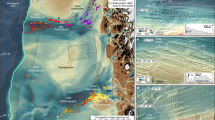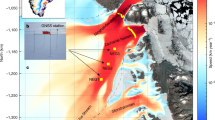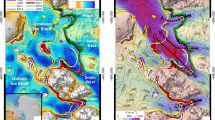Abstract
Grounding lines are a key indicator of ice-sheet instability, because changes in their position reflect imbalance with the surrounding ocean and affect the flow of inland ice. Although the grounding lines of several Antarctic glaciers have retreated rapidly due to ocean-driven melting, records are too scarce to assess the scale of the imbalance. Here, we combine satellite altimeter observations of ice-elevation change and measurements of ice geometry to track grounding-line movement around the entire continent, tripling the coverage of previous surveys. Between 2010 and 2016, 22%, 3% and 10% of surveyed grounding lines in West Antarctica, East Antarctica and at the Antarctic Peninsula retreated at rates faster than 25 m yr−1 (the typical pace since the Last Glacial Maximum) and the continent has lost 1,463 km2 ± 791 km2 of grounded-ice area. Although by far the fastest rates of retreat occurred in the Amundsen Sea sector, we show that the Pine Island Glacier grounding line has stabilized, probably as a consequence of abated ocean forcing. On average, Antarctica’s fast-flowing ice streams retreat by 110 metres per metre of ice thinning.
This is a preview of subscription content, access via your institution
Access options
Access Nature and 54 other Nature Portfolio journals
Get Nature+, our best-value online-access subscription
$29.99 / 30 days
cancel any time
Subscribe to this journal
Receive 12 print issues and online access
$259.00 per year
only $21.58 per issue
Buy this article
- Purchase on Springer Link
- Instant access to full article PDF
Prices may be subject to local taxes which are calculated during checkout


Similar content being viewed by others
References
Weertman, J. Stability of the junction of an ice sheet and an ice shelf. J. Glaciol. 13, 3–11 (1974).
Schoof, C. Ice sheet grounding line dynamics: steady states, stability, and hysteresis. J. Geophys. Res. 112, F03S28 (2007).
Rignot, E. et al. Recent Antarctic ice mass loss from radar interferometry and regional climate modelling. Nat. Geosci. 1, 106–110 (2008).
Docquier, D., Perichon, L. & Pattyn, F. Representing grounding line dynamics in numerical ice sheet models: recent advances and outlook. Surv. Geophys. 32, 417–435 (2011).
Pollard, D. & DeConto, R. M. Modelling West Antarctic ice sheet growth and collapse through the past five million years. Nature 458, 329–332 (2009).
Scambos, T. A., Bohlander, J. A., Shuman, C. A. & Skvarca, P. Glacier acceleration and thinning after ice shelf collapse in the Larsen B embayment, Antarctica. Geophys. Res. Lett. 31, L18402 (2004).
Shepherd, A. et al. Recent loss of floating ice and the consequent sea level contribution. Geophys. Res. Lett. 37, L13503 (2010).
Rignot, E., Jacobs, S., Mouginot, J. & Scheuchl, B. Ice-shelf melting around Antarctica. Science 341, 266–270 (2013).
Bentley, M. J. et al. A community-based geological reconstruction of Antarctic Ice Sheet deglaciation since the Last Glacial Maximum. Quat. Sci. Rev. 100, 1–9 (2014).
Rignot, E. J. Fast recession of a West Antarctic glacier. Science 281, 549–551 (1998).
Park, J. W. et al. Sustained retreat of the Pine Island Glacier. Geophys. Res. Lett. 40, 2137–2142 (2013).
Rignot, E., Mouginot, J., Morlighem, M., Seroussi, H. & Scheuchl, B. Widespread, rapid grounding line retreat of Pine Island, Thwaites, Smith, and Kohler glaciers, West Antarctica, from 1992 to 2011. Geophys. Res. Lett. 41, 3502–3509 (2014).
Christie, F. D. W., Bingham, R. G., Gourmelen, N., Tett, S. F. B. & Muto, A. Four-decade record of pervasive grounding line retreat along the Bellingshausen margin of West Antarctica. Geophys. Res. Lett. 43, 5741–5749 (2016).
Li, X., Rignot, E., Morlighem, M., Mouginot, J. & Scheuchl, B. Grounding line retreat of Totten Glacier, East Antarctica, 1996 to 2013. Geophys. Res. Lett. 42, 8049–8056 (2015).
Scheuchl, B., Mouginot, J., Rignot, E., Morlighem, M. & Khazendar, A. Grounding line retreat of Pope, Smith, and Kohler Glaciers, West Antarctica, measured with Sentinel-1a radar interferometry data. Geophys. Res. Lett. 43, 8572–8579 (2016).
Joughin, I., Smith, B. E. & Medley, B. Marine ice sheet collapse potentially under way for the Thwaites Glacier Basin, West Antarctica. Science 344, 735–738 (2014).
DeConto, R. M. & Pollard, D. Contribution of Antarctica to past and future sea-level rise. Nature 531, 591–597 (2016).
Fricker, H. A. et al. Redefinition of the Amery Ice Shelf, East Antarctica, grounding zone. J. Geophys. Res. 107, ECV 1-1–ECV 1-9 (2002).
Horgan, H. J. & Anandakrishnan, S. Static grounding lines and dynamic ice streams: evidence from the Siple Coast, West Antarctica. Geophys. Res. Lett. 33, L18502 (2006).
Goldstein, R. M., Engelhardt, H., Kamb, B. & Frolich, R. M. Satellite radar interferometry for monitoring ice sheet motion: application to an Antarctic ice stream. Science 262, 1525–1530 (1993).
Gray, L. et al. RADARSAT interferometry for Antarctic grounding-zone mapping. Ann. Glaciol. 34, 269–276 (2002).
Shepherd, A., Wingham, D. J. & Mansley, J. A. D. Inland thinning of the Amundsen Sea sector, West Antarctica. Geophys. Res. Lett. 29, 2–4 (2002).
McMillan, M. et al. Increased ice losses from Antarctica detected by CryoSat-2. Geophys. Res. Lett. 41, 3899–3905 (2014).
Fretwell, P. et al. Bedmap2: improved ice bed, surface and thickness datasets for Antarctica. Cryosphere 7, 375–393 (2013).
Rignot, E., Mouginot, J. & Scheuchl, B. Antarctic grounding line mapping from differential satellite radar interferometry. Geophys. Res. Lett. 38, L10504 (2011).
Smith, J. A. et al. New constraints on the timing of West Antarctic Ice Sheet retreat in the eastern Amundsen Sea since the Last Glacial Maximum. Glob. Planet. Change 122, 224–237 (2014).
Pollard, D., Chang, W., Haran, M., Applegate, P. & DeConto, R. Large ensemble modeling of the last deglacial retreat of the West Antarctic Ice Sheet: comparison of simple and advanced statistical techniques. Geosci. Model Dev. 9, 1697–1723 (2016).
Pritchard, H. D., Arthern, R. J., Vaughan, D. G. & Edwards, L. A. Extensive dynamic thinning on the margins of the Greenland and Antarctic ice sheets. Nature 461, 971–975 (2009).
Lenaerts, J. T. M. et al. Recent snowfall anomalies in Dronning Maud Land, East Antarctica, in a historical and future climate perspective. Geophys. Res. Lett. 40, 2684–2688 (2013).
Boening, C., Lebsock, M., Landerer, F. & Stephens, G. Snowfall-driven mass change on the East Antarctic ice sheet. Geophys. Res. Lett. 39, L21501 (2012).
Jenkins, A. et al. Observations beneath Pine Island Glacier in West Antarctica and implications for its retreat. Nat. Geosci. 3, 468–472 (2010).
Rintoul, S. R. et al. Ocean heat drives rapid basal melt of the Totten Ice Shelf. Sci. Adv. 2, e1601610 (2016).
Holland, P. R., Jenkins, A. & Holland, D. M. Ice and ocean processes in the Bellingshausen Sea, Antarctica. J. Geophys. Res. Ocean 115, C05020 (2010).
Hogg, A. E. et al. Increased ice flow in Western Palmer Land linked to ocean melting. Geophys. Res. Lett. 44, 4159–4167 (2017).
Konrad, H. et al. Uneven onset and pace of ice-dynamical imbalance in the Amundsen Sea Embayment, West Antarctica. Geophys. Res. Lett. 44, 910–918 (2017).
Dutrieux, P. et al. Strong sensitivity of Pine Island ice-shelf melting to climatic variability. Science 343, 174–178 (2014).
Joughin, I., Shean, D. E., Smith, B. E. & Dutrieux, P. Grounding line variability and subglacial lake drainage on Pine Island Glacier, Antarctica. Geophys. Res. Lett. 43, 9093–9102 (2016).
Milillo, P. et al. On the short-term grounding zone dynamics of Pine Island Glacier, West Antarctica, observed with COSMO-SkyMed interferometric data. Geophys. Res. Lett. 44, 436–444 (2017).
Joughin, I. et al. Continued deceleration of Whillans ice stream West Antartica. Geophys. Res. Lett. 32, L22501 (2005).
de, Q. & Robin, G. Surface topography of ice sheets. Nature 215, 1029–1032 (1967).
Smith, A. M. et al. Rapid erosion, drumlin formation, and changing hydrology beneath an Antarctic ice stream. Geology 35, 127–130 (2007).
van den Berg, J., van de Wal, R. S. W., Milne, G. A. & Oerlemans, J. Effect of isostasy on dynamical ice sheet modeling: a case study for Eurasia. J. Geophys. Res. 113, B05412 (2008).
Jacobs, S. S., Jenkins, A., Giulivi, C. F. & Dutrieux, P. Stronger ocean circulation and increased melting under Pine Island Glacier ice shelf. Nat. Geosci. 4, 519–523 (2011).
Mouginot, J., Scheuchl, B. & Rignot, E. Mapping of ice motion in Antarctica using synthetic-aperture radar data. Remote Sens. 4, 2753–2767 (2012).
Ligtenberg, S. R. M., Horwath, M., van den Broeke, M. R. & Legrésy, B. Quantifying the seasonal ‘breathing’ of the Antarctic ice sheet. Geophys. Res. Lett. 39, L23501 (2012).
Shepherd, A. et al. A reconciled estimate of ice-sheet mass balance. Science 338, 1183–1189 (2012).
Martín-Español, A. et al. An assessment of forward and inverse GIA solutions for Antarctica. J. Geophys. Res. 121, 6947–6965 (2016).
Armitage, T. W. K., Wingham, D. J. & Ridout, A. L. Meteorological origin of the static crossover pattern present in low-resolution-mode CryoSat-2 data over central Antarctica. IEEE Geosci. Remote Sens. Lett. 11, 1295–1299 (2014).
Griggs, J. A. & Bamber, J. L. Antarctic ice-shelf thickness from satellite radar altimetry. J. Glaciol. 57, 485–498 (2011).
Krystek, M. & Anton, M. A least-squares algorithm for fitting data points with mutually correlated coordinates to a straight line. Meas. Sci. Technol. 18, 3438–3442 (2007).
Rignot, E., Mouginot, J. & Scheuchl, B. MEaSUREs InSAR-Based Antarctica Ice Velocity Map (NASA National Snow and Ice Data Center Distributed Active Archive Center, Boulder, CO, 2011); https://doi.org/10.5067/MEASURES/CRYOSPHERE/nsidc-0484.001
Rignot, E., Mouginot, J. & Scheuchl, B. MEaSUREs Antarctic Grounding Line from Differential Satellite Radar Interferometry, Version 2 (NASA National Snow and Ice Data Center Distributed Active Archive Center, Boulder, CO, 2016); https://doi.org/10.5067/IKBWW4RYHF1Q
Acknowledgements
We acknowledge the European Space Agency (ESA) for the provision of CryoSat-2 data and ESA’s Antarctic_Ice Sheet_cci, as well as the UK Natural Environment Research Council’s (NERC) Centre for Polar Observation and Modelling (CPOM) for processing of these data. H.K. was funded through the NERC’s iSTAR Programme and NERC Grant Number NE/J005681/1. A.E.H. was supported by an independent research fellowship (no. 4000112797/15/I-SBo) jointly funded by ESA, the University of Leeds and the British Antarctic Survey. The figures were produced using the Generic Mapping Tool (https://doi.org/10.1029/90EO00319).
Author information
Authors and Affiliations
Contributions
H.K., A.S., A.E.H. and M.M. designed the study. L.G. and A.M. processed CryoSat-2 data. H.K., A.S., A.E.H., M.M. and T.S. analysed the results. H.K. and A.S. wrote the manuscript. All authors contributed to revising the manuscript.
Corresponding author
Ethics declarations
Competing interests
The authors declare no competing interests.
Additional information
Publisher’s note: Springer Nature remains neutral with regard to jurisdictional claims in published maps and institutional affiliations.
Supplementary information
Supplementary Information
Supplementary Figures, Table 1 and References.
Supplementary Table 2
Surface elevation and grounding-line migration
Rights and permissions
About this article
Cite this article
Konrad, H., Shepherd, A., Gilbert, L. et al. Net retreat of Antarctic glacier grounding lines. Nature Geosci 11, 258–262 (2018). https://doi.org/10.1038/s41561-018-0082-z
Received:
Accepted:
Published:
Issue Date:
DOI: https://doi.org/10.1038/s41561-018-0082-z
This article is cited by
-
Remotely sensing potential climate change tipping points across scales
Nature Communications (2024)
-
Ross Gyre variability modulates oceanic heat supply toward the West Antarctic continental shelf
Communications Earth & Environment (2024)
-
Rapid, buoyancy-driven ice-sheet retreat of hundreds of metres per day
Nature (2023)
-
Inter-decadal climate variability induces differential ice response along Pacific-facing West Antarctica
Nature Communications (2023)
-
Future sea-level projections with a coupled atmosphere-ocean-ice-sheet model
Nature Communications (2023)




